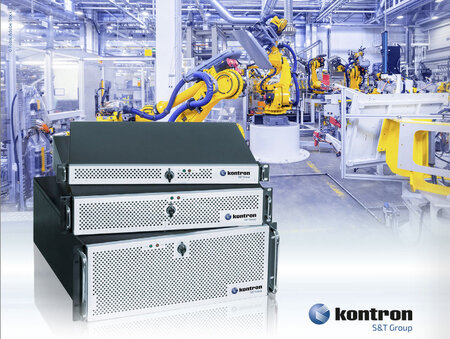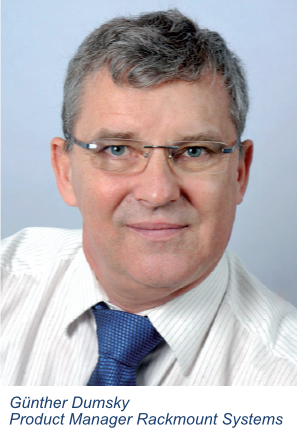 I
I
In our interview, Kontron Product Manager Günther Dumsky explains, why it makes sense to develop the 19" housings for Kontron's KISS rackmount systems in-house and how the customer benefits from the in-house design.
 Kontron Blog Team: Mr. Dumsky, please explain to us the disadvantages of integrating your products into conventional off-the-shelf housings from Asia.
Kontron Blog Team: Mr. Dumsky, please explain to us the disadvantages of integrating your products into conventional off-the-shelf housings from Asia.
Günther Dumsky: Have you ever built a 300 hp engine into a Trabbi? No? please don´ t try it! The sheet thickness of conventional off-the-shelf cases - which is due to used tools and the price - usually is only 0.8 mm, which has a negative effect on stiffness, stability and torsion resistance. These features quickly have a negative impact, especially during transport and use in environments with high vibrations.
Kontron Blog Team: What is the sheet thickness of your in-house manufactured housings?
Günther Dumsky: The sheet thickness of our housings ranges from 1.0 mm to 1.6 mm, which increases stability and prevents torsion. In addition, our material is hot-dip galvanized steel sheet and thus long-term EMC stable, which means that even with high humidity and high temperatures in continuous operation, the guaranteed EMC features will not give in.
Kontron Blog Team: And what about customer-specific adaptations? Can off-the-shelf housings be continuously optimized, or is this something that can only be achieved by an in-house design?
Günther Dumsky: That's right, only our in-house design can do that satisfactorily. Conventional off-the-shelf housings get designed for a tool only one time and are no longer optimized afterwards, as this would mean, that a new, expensive tool would have to be purchased. The consequence is, that these cases can no longer be easily adapted to current requirements, e.g. better cooling for more powerful CPUs, installation options for more modern drives, etc. Even adaptations to customer-specific requirements for small and medium quantities are therefore difficult to implement. For example, the customer would like to have a redundant power supply installed? This is only possible off-the-shelf with complex additional parts, which then also impair the assembly/maintenance friendliness. As we have the housing know-how in-house, our engineers can implement customer wishes flexibly, quickly and effectively and thus shorten the time-to-market immensely. A further advantage is, that no one-off costs are incurred for minor adjustments.
Kontron Blog Team: As for Design - does Kontron's in-house design offer customers the opportunity to adapt their housings to their individual requirements?
Günther Dumsky: Of course! An unmistakable design has become a requirement of many of our customers, and our claim is also a certain recognition value of our products. This is not possible with a conventional off-the-shelf housing, which can be purchased from many distributors worldwide. Our flexible, mechanical concept allows, for example, the front doors of our systems to be easily and cost-effectively adapted to customer requirements, e.g. with regard to colour, design and printing.
Kontron Blog Team: What additional functionality do your housings offer?
Günther Dumsky: For example, Kontron has developed an effective, optimal "Cooling Concept" for all 19" systems of the KISS family, which allows our customers to operate their computers at up to 50°C in 24/7 mode. We have also come up with something on the subject of 'security': The lid of our housing cannot be removed from the system without being destroyed when the flap is closed, so that unwanted access to drives and I/OS from the front is effectively prevented. Our customers also want their systems to be as easy and stress-free as possible to maintain and repair. Of course, we have also complied with this wish: Hot-swap chassis and fan filters reduce the MTTR many times over, as they can be replaced during operation without tools. In addition, the system can be quickly and stress-free opened for upgrades without tools. Our KISS computers also offer the possibility of connecting heavy full-length CPU cards or GPU cards to the housing by means of a third fixing option, thus preventing transport damage or damage in harsh industrial environments. And our special shock and vibration suspension for drive cages allows rotating mass storage devices to operate reliably in continuous operation even under high shock and vibration loads.
Kontron Blog Team: How long has Kontron been developing its 19" housings of the KISS product family by itself and how do you benefit from your in-house know-how?
We started developing the rackmount housings ourselves more than 30 years ago. In the meantime, many years of personal experience and feedback from many of our customers have gone into these housings. Nevertheless, they have of course not become expensive, „all in one“ fancy stuff. Our aim was to develop a modern, flexible housing design through permanent optimization and cost reduction, which would enable us to meet a wide range of requirements in a wide variety of applications. The exchange of experience with our customers has also led to additional functionalities being integrated into the enclosures through additional, cost-neutral adaptations. We would also like to take this opportunity to thank our customers once again for working with us to create this extraordinary product family!
What other advantages does in-house design offer from your point of view? We are looking forward to your comments!


{{comment.comment}}